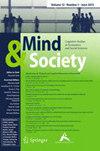A Comparative Study of Mental Health Issues among Tattooed and Non-tattooed Young Adults
Q1 Arts and Humanities
引用次数: 0
Abstract
The present research work titled, ‘A Comparative Study of Mental Health Issues Among Tattooed and Non-Tattooed Young Adults’, is based on the enquiry, could many tattoos, in different parts of the body done over a period of time, an indication of onset of mental illness? Why people willingly inflict pain on their body? Do the young adults who get multiple tattoos on different parts of their body have mental health issues? The objectives of the study wereto study themental health of young tattooed adults with the Hypotheses: a) There will be an effect of tattoos on the mental health of young adults with tattoos on different parts of the body, and b) There will be a significant difference between the mental health of tattooed and non-tattooed young adults and the Variablesbeingtattoo (IV) and mental health (DV). Tool: Mental Health Inventory by Jagdish and A.K. Srivastava (1983) that has 56 questions covering six dimensions i.e., positive self-evaluation (10 questions), perception of reality (8 questions), integration of personality (12 questions), autonomy (6 questions), group-oriented attitudes (10 questions), and environmental mastery (10 questions). The Sample Populationwas 60 young adults between the age range of 18 and 25 years (30 with tattoos on different parts of the body and 30 without tattoos) using purposive sampling and Exploratory Research Design. The statistical analysis was done using Descriptive Statisticst test and correlation. This study clearly indicates that tattooed young adults scored poorly in mental health status.文身与非文身青年心理健康问题的比较研究
目前的研究工作题为“有纹身和没有纹身的年轻人的心理健康问题的比较研究”,是基于这样一个问题:在一段时间内,在身体的不同部位有很多纹身,这是否意味着精神疾病的发作?为什么人们愿意给自己的身体施加痛苦?那些在身体不同部位纹身的年轻人是否有心理健康问题?本研究的目的是研究有纹身的年轻成年人的心理健康,假设:a)纹身会对身体不同部位纹身的年轻人的心理健康产生影响,b)有纹身和没有纹身的年轻人的心理健康会有显著差异,变量是纹身(IV)和心理健康(DV)。工具:Jagdish和A.K. Srivastava(1983)的心理健康量表,有56个问题,涵盖六个维度,即积极的自我评价(10个问题),对现实的感知(8个问题),个性整合(12个问题),自主性(6个问题),群体导向态度(10个问题)和环境掌握(10个问题)。样本人群是60名年龄在18到25岁之间的年轻人(30人在身体的不同部位有纹身,30人没有纹身),采用了有目的的抽样和探索性研究设计。统计分析采用描述性统计检验和相关分析。这项研究清楚地表明,有纹身的年轻人在心理健康状况方面得分较低。
本文章由计算机程序翻译,如有差异,请以英文原文为准。
求助全文
约1分钟内获得全文
求助全文
来源期刊

Mind and Society
Arts and Humanities-Philosophy
CiteScore
2.30
自引率
0.00%
发文量
5
期刊介绍:
Mind & Society is a journal for ideas, explorations, investigations and discussions on the interaction between the human mind and the societal environments. Scholars from all fields of inquiry who entertain and examine various aspects of these interactions are warmly invited to submit their work. The journal welcomes case studies, theoretical analysis and modeling, data analysis and reports (quantitative and qualitative) that can offer insight into existing frameworks or offer views and reason for the promise of new directions for the study of interaction between the mind and the society. The potential contributors are particularly encouraged to carefully consider the impact of their work on societal functions in private and public sectors, and to dedicate part of their discussion to an explicit clarification of such, existing or potential, implications.Officially cited as: Mind Soc
 求助内容:
求助内容: 应助结果提醒方式:
应助结果提醒方式:


